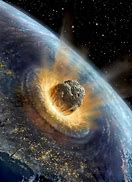As a boy, I remember sitting in the front yard thinking about the possibility of an asteroid hitting the earth. I decided we’d have to figure out a way to blast them before they hit. Then I forgot all about it and went off to play.
I was not the first to contemplate the threat of an asteroid impact. In 1757 Benjamin Franklin speculated that “the great Power that made the earth” would govern such events and would not let it happen “till ‘tis best it should.” In 1822, Lord Byron, always prone to imaginative thinking, said, “Who knows whether….men will not tear rocks from their foundations by means of steam, and hurl mountains, as the giants are said to have done, against the flaming mass? – and then we shall have traditions of Titans again, and of wars with Heaven.”
Sixty-five million years ago, an impact event occurred in the Yucatan region of Mexico. The Chicxulub impact is believed to have caused global-scale environmental effects that led to the extinction of the dinosaurs.
Every day, Earth is bombarded with more than 100 tons of dust and sand-sized particles from space. About once a year, an automobile-sized asteroid hits Earth’s atmosphere, creating a spectacular fireball (bolide) event as the friction of Earth’s atmosphere causes them to disintegrate.
Fortunately, some enterprising young scientists were not as easily distracted as I was as a boy. They have been working on the problem. On Sept. 26, 2022: After 10 months flying in space, NASA’s Double Asteroid Redirection Test (DART) – the world’s first planetary defense technology demonstration – successfully impacted its asteroid target, the agency’s first attempt to move an asteroid in space.
This accomplishment could be described as the equivalent of you or I shooting a dime being held up by a Hell’s Angel traveling 200 miles an hour three miles away.
The idea is to catalogue all potential impact threats and change their trajectories if necessary so that we do not have to worry about going the way of the dinosaurs.
NASA will host a media briefing at 2 p.m. EDT, Tuesday, Oct. 11, to discuss the agency’s DART mission and its intentional collision with its target asteroid, Dimorphos.
Stay tuned!


“…shooting a dime being held up by a Hell’s Angel traveling 200 miles an hour three miles away.” It is this kind of writing that makes you a finalist for the Royal Palm Literary Award Competition.
Instead of spending billions more on the International Space Station and the Artemis moon rocket, invest that money in planetary defense.
And don’t forget strategic missile defense. Putin and Xi haven’t forgotten.
I stole the analogy. The source has been lost to me in the quicksands of time.